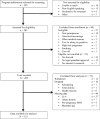Associations Among Child Abuse, Depression, and Interleukin-6 in Pregnant Adolescents: Paradoxical Findings
- PMID: 27187846
- PMCID: PMC5067964
- DOI: 10.1097/PSY.0000000000000344
Associations Among Child Abuse, Depression, and Interleukin-6 in Pregnant Adolescents: Paradoxical Findings
Abstract
Objective: Limited data exist on child abuse-related immune variation during pregnancy, despite implications for maternal and infant health and extensive data showing that abuse history and depression are related to increased inflammation in other populations. This study examined associations among child abuse, depression, circulating levels of inflammatory markers, and perinatal health in pregnant adolescents, a group at high risk for childhood abuse and poor birth outcomes.
Methods: Pregnant teenagers (n = 133; 14-19 years; 89.5% Latina) reported on abuse and depression and had two blood draws (24-27 and 34-37 gestational weeks, second and third trimesters, respectively) for interleukin-6 (IL-6) and C-reactive protein; birth outcomes were collected.
Results: Abuse and depression interacted to predict higher IL-6 at second trimester (B = 0.006, p = .011) such that severely abused adolescents with high depression had higher IL-6 relative to severely abused adolescents with low depression; depression did not differentiate IL-6 levels for those with low abuse severity. Abuse and IL-6 also interacted to predict gestational age at birth (B = 0.004, p = .040) such that those with low abuse and high IL-6 and those with high abuse and low IL-6 had infants with earlier gestational age at birth. Cortisol at the second trimester mediated the association between IL-6 and gestational age at birth (indirect effect estimate=-0.143, p < .039).
Conclusions: Depression severity distinguished IL-6 levels among more severely abused pregnant Latina adolescents, but it was unrelated to IL-6 among less severely abused adolescents. Cortisol explained the relationship between IL-6 and earlier gestational age at birth. Multiple adversities and inflammation may influence birth outcomes and potentially affect intergenerational health.
Figures


Similar articles
-
Depressive symptoms and gestational length among pregnant adolescents: Cluster randomized control trial of CenteringPregnancy® plus group prenatal care.J Consult Clin Psychol. 2017 Jun;85(6):574-584. doi: 10.1037/ccp0000191. Epub 2017 Mar 13. J Consult Clin Psychol. 2017. PMID: 28287802 Free PMC article. Clinical Trial.
-
Adolescent Pregnancy Guidelines.J Obstet Gynaecol Can. 2015 Aug;37(8):740-756. doi: 10.1016/S1701-2163(15)30180-8. J Obstet Gynaecol Can. 2015. PMID: 26474231
-
Abuse during pregnancy: effects on maternal complications and birth weight in adult and teenage women.Obstet Gynecol. 1994 Sep;84(3):323-8. Obstet Gynecol. 1994. PMID: 8058224
-
Childhood victimization: relationship to adolescent pregnancy outcome.Child Abuse Negl. 1994 Jul;18(7):569-75. doi: 10.1016/0145-2134(94)90083-3. Child Abuse Negl. 1994. PMID: 7922731
-
[WEIGHT GAIN DURING PREGNANCY AND PERINATAL OUTCOMES IN PREGNANT ADOLESCENTS WITH A HISTORY OF SEXUAL ABUSE].Nutr Hosp. 2015 Sep 1;32(3):1075-81. doi: 10.3305/nh.2015.32.3.9377. Nutr Hosp. 2015. PMID: 26319823 Spanish.
Cited by
-
A Brief Historic Review of Research on Early Life Stress and Inflammation across the Lifespan.Neuroimmunomodulation. 2025;32(1):24-35. doi: 10.1159/000542676. Epub 2024 Nov 27. Neuroimmunomodulation. 2025. PMID: 39602905 Review.
-
Examination of the role of obesity in the association between childhood trauma and inflammation during pregnancy.Health Psychol. 2018 Feb;37(2):114-124. doi: 10.1037/hea0000559. Epub 2017 Oct 2. Health Psychol. 2018. PMID: 28967771 Free PMC article.
-
Is There an Inflammatory Profile of Perinatal Depression?Curr Psychiatry Rep. 2023 Apr;25(4):149-164. doi: 10.1007/s11920-023-01414-y. Epub 2023 Mar 22. Curr Psychiatry Rep. 2023. PMID: 36947355 Review.
-
Exposure to childhood maltreatment and systemic inflammation across pregnancy: The moderating role of depressive symptomatology.Brain Behav Immun. 2022 Mar;101:397-409. doi: 10.1016/j.bbi.2022.02.004. Epub 2022 Feb 5. Brain Behav Immun. 2022. PMID: 35131443 Free PMC article.
-
Childhood maltreatment and inflammation among pregnant women with gestational diabetes mellitus: A pilot study.Obstet Med. 2017 Sep;10(3):120-124. doi: 10.1177/1753495X17701320. Epub 2017 May 10. Obstet Med. 2017. PMID: 29051779 Free PMC article.
References
-
- Darroch JE, Singh S, Frost JJ. Differences in teenage pregnancy rates among five developed countries: The roles of sexual activity and contraceptive use. Family planning perspectives. 2001;33:244–250, 281. - PubMed
-
- Herrenkohl EC, Herrenkohl RC, Egolf BP, Russo MJ. The relationship between early maltreatment and teenage parenthood. Journal of adolescence. 1998;21:291–303. - PubMed
-
- Chen X-K, Wen SW, Fleming N, Demissie K, Rhoads GG, Walker M. Teenage pregnancy and adverse birth outcomes: A large population based retrospective cohort study. International journal of epidemiology. 2007;36:368–373. - PubMed
MeSH terms
Substances
Grants and funding
LinkOut - more resources
Full Text Sources
Other Literature Sources
Medical
Research Materials

